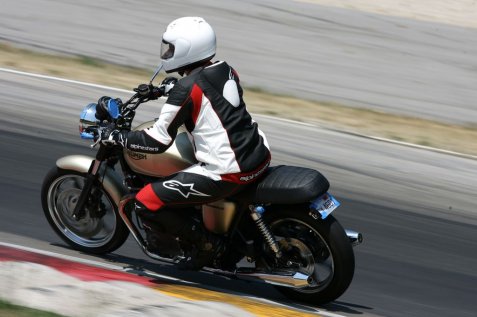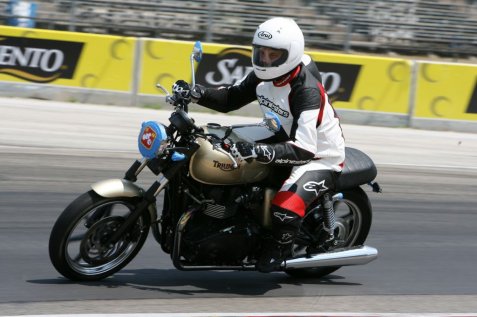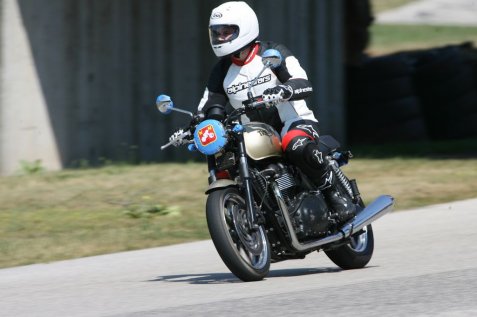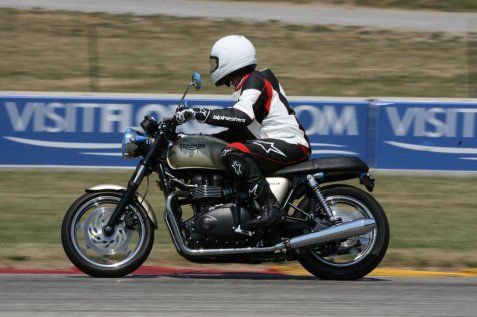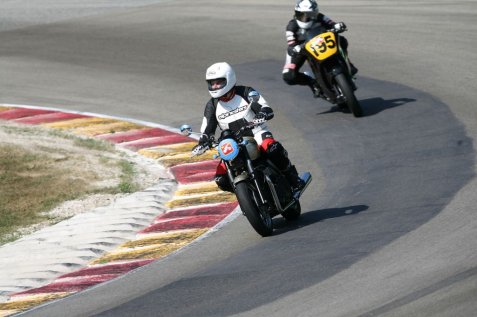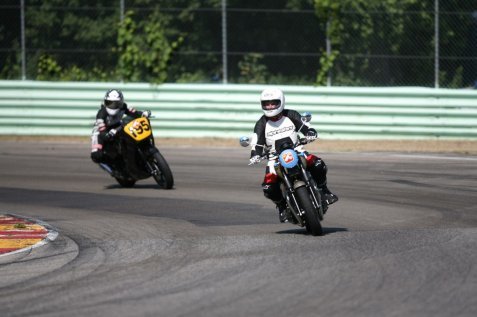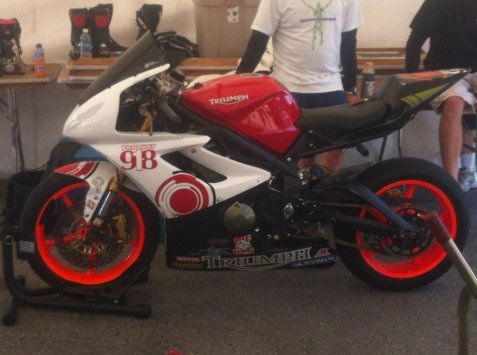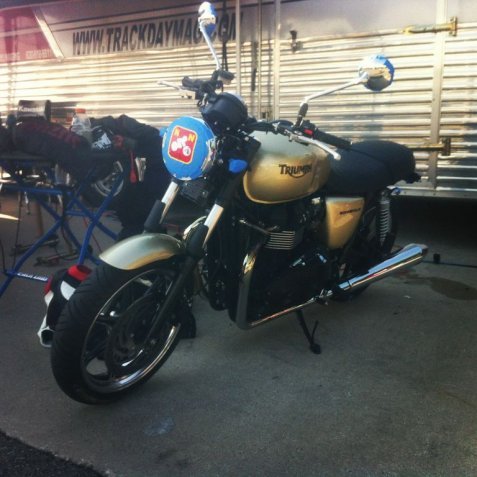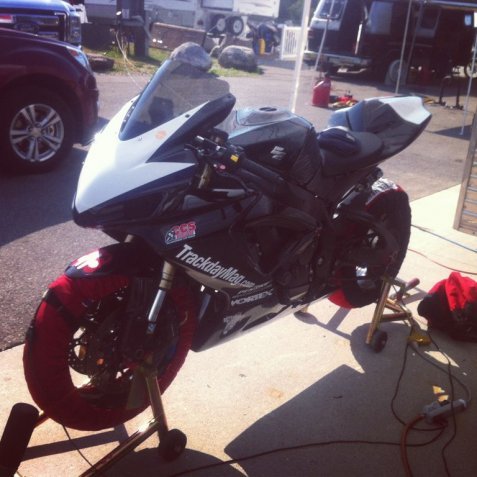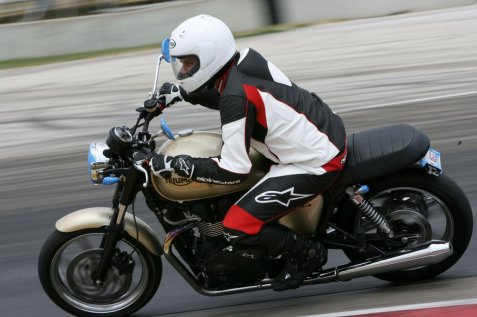

|

|
Every office has that cheesy motivational poster that says, “By failing to prepare, you are preparing for failure.” “Office Space” flashbacks aside, when it comes to your first track day, preparation is crucial. But more than just going fast, a track day gives you the opportunity to be a part of one of the best communities of motorcycling that will help you even if you don’t have the tools or experience. The track will also provide you with an experience you can’t replicate anywhere else on the street.
Choose a School
Whether it’s your first time at the track or your 50th, you’re going to need to find a host to go through. For my first track day, I chose Superbike Track Time (STT) after a strong recommendation from my dealer at Motoworks Chicago. Ask your dealer too – they often have the contacts and experience needed to find the perfect host for you.
For my first excursion, I rode up to Road America in Elkhart Lake, WI on a day so hot it would make the devil sweat bullets. I also came seriously unprepared to a very serious racetrack. Upon riding into pit road with nothing more than a backpack with some tools and water, I noticed that everyone else was prepared with trailers, tools, tents, and everything else needed to go throughout the day. Not a calming start to the day.
One Big Fast Family
Luckily, this is where the community aspect comes in. Upon seeing my lack of tools, knowledge, and experience, the guys from Trackdaymag.com took me under their wing. With their help, I was able to quickly learn what and what not to do on a track day. And everyone there was just as friendly. Racing is a seriously dangerous hobby, but this shared threat binds this group together. So even if you don’t come completely prepared, someone will help you through so that you can pay it forward when you see someone that shows up unprepared.
The Uniform of Speed
The one thing I did come prepared with was the proper gear needed for my first track excursion. Some track schools, like STT, have leathers you can rent for the day free of charge, but for those looking to do more track days, or are even semi-experienced, Alpinestars has a range of gear that you can call your own without breaking the bank.
A race suit is necessary for the track, but can get pricey. Alpinestars offers a two-piece that compromises on price but not quality. Built with all the necessary armor and reinforcements, the Carver is a great alternative to a one-piece suit. If it’s your first time wearing leathers, prepare to regret that last Big Mac you ate. The fit is good, but if you’re not cut like a pro racer, it’s not flattering. Use it as motivation to hit the gym; I know I will.
Along the lines of the Carver suit, Alpinestars also offers two midrange boot and glove options. For my ride out, Alpinestars supplied GP Pro gloves and S-MX Plus Boots. Both are a step up from their street oriented counterparts. The gloves are a full gauntlet, and have a sewn Kevlar fabric in the top of the glove, along with more armor and bridged third and fourth fingers. The boots add an inner boot for a tighter fit, along with Multi Link Control, which is their system to customize the fit even further from outside the boot.
Of course, you will also need a helmet; every school varies on what standards they use, so check your lid before you go out there.
All told, the gear is a serious investment, but one that should not be scrimped on. These options from Alpinestars are great for those that want to go to the track on a semi-regular basis, but aren’t totally committed yet, or for beginners that need their first set of leathers. Remember, it might cost as much as that new exhaust for your bike, but no exhaust will save your life.
Going Fastish
With the bike taped up and the first class session over, it was then time for my first out lap on the track. After years of thinking about speed limits, police, and other drivers, here you are with the leash completely off, free to go as fast as you want; and it’s terrifying. Road America is a fast, 4-mile track that has been the venue of everything from F1 to top motorcycle racers, and now you have to try to go quick on it. It is just you and the bike out there trying your best, but get it wrong and it’s you vs. the track. The first out lap was a low speed tour to get used to the layout and exit points. Track “low speed” is very different than street, however, since you’re still going at highway speeds.
At first, my experience with the track was awkward. I wasn’t leaning enough, I wasn’t looking far ahead enough, and I was carrying my bad habits with me from the street to the track. Bu this is the value of a track day. After the first session, the instructor pulls you aside, calmly tells you what to work on, and you try again. By the second session, not only was a doing better, but I was more comfortable. When things start to slow down, even though you’re going faster, everything starts to make sense. The bike and you begin to work together. By the end of the day, I was more confident on the bike, which helps on the street as well.
The track is less about going “fast” than it is about improving yourself. Fast is relative. When you think you’re going fast, you’re not. The same day I was at STT, Jason DiSalvo was there with his track day school as well. An AMA rider for Triumph, watching him effortlessly annihilate the track is a wakeup call that you are not hot shit. The gains you make during a track day are personal ones, but just as satisfying, and they help you test you’re limits in a safer environment than on public roads.
Get Out There
I came unprepared, on a bike that was completely out of place among modern sportbikes, but with the friendly atmosphere and an open mind, anyone can have fun at the track. It will teach you more than you think about how your bike handles, and it’s an experience in and of itself to at least try. I mean, how many times are you going to be on a bike and someone orders you to go faster?
Every office has that cheesy motivational poster that says, “By failing to prepare, you are preparing for failure.” “Office Space” flashbacks aside, when it comes to your first track day, preparation is crucial. But more than just going fast, a track day gives you the opportunity to be a part of one of the best communities of motorcycling that will help you even if you don’t have the tools or experience. The track will also provide you with an experience you can’t replicate anywhere else on the street.
Choose a School
Whether it’s your first time at the track or your 50th, you’re going to need to find a host to go through. For my first track day, I chose Superbike Track Time (STT) after a strong recommendation from my dealer at Motoworks Chicago. Ask your dealer too – they often have the contacts and experience needed to find the perfect host for you.
For my first excursion, I rode up to Road America in Elkhart Lake, WI on a day so hot it would make the devil sweat bullets. I also came seriously unprepared to a very serious racetrack. Upon riding into pit road with nothing more than a backpack with some tools and water, I noticed that everyone else was prepared with trailers, tools, tents, and everything else needed to go throughout the day. Not a calming start to the day.
One Big Fast Family
Luckily, this is where the community aspect comes in. Upon seeing my lack of tools, knowledge, and experience, the guys from Trackdaymag.com took me under their wing. With their help, I was able to quickly learn what and what not to do on a track day. And everyone there was just as friendly. Racing is a seriously dangerous hobby, but this shared threat binds this group together. So even if you don’t come completely prepared, someone will help you through so that you can pay it forward when you see someone that shows up unprepared.
The Uniform of Speed
The one thing I did come prepared with was the proper gear needed for my first track excursion. Some track schools, like STT, have leathers you can rent for the day free of charge, but for those looking to do more track days, or are even semi-experienced, Alpinestars has a range of gear that you can call your own without breaking the bank.
A race suit is necessary for the track, but can get pricey. Alpinestars offers a two-piece that compromises on price but not quality. Built with all the necessary armor and reinforcements, the Carver is a great alternative to a one-piece suit. If it’s your first time wearing leathers, prepare to regret that last Big Mac you ate. The fit is good, but if you’re not cut like a pro racer, it’s not flattering. Use it as motivation to hit the gym; I know I will.
Along the lines of the Carver suit, Alpinestars also offers two midrange boot and glove options. For my ride out, Alpinestars supplied GP Pro gloves and S-MX Plus Boots. Both are a step up from their street oriented counterparts. The gloves are a full gauntlet, and have a sewn Kevlar fabric in the top of the glove, along with more armor and bridged third and fourth fingers. The boots add an inner boot for a tighter fit, along with Multi Link Control, which is their system to customize the fit even further from outside the boot.
Of course, you will also need a helmet; every school varies on what standards they use, so check your lid before you go out there.
All told, the gear is a serious investment, but one that should not be scrimped on. These options from Alpinestars are great for those that want to go to the track on a semi-regular basis, but aren’t totally committed yet, or for beginners that need their first set of leathers. Remember, it might cost as much as that new exhaust for your bike, but no exhaust will save your life.
Going Fastish
With the bike taped up and the first class session over, it was then time for my first out lap on the track. After years of thinking about speed limits, police, and other drivers, here you are with the leash completely off, free to go as fast as you want; and it’s terrifying. Road America is a fast, 4-mile track that has been the venue of everything from F1 to top motorcycle racers, and now you have to try to go quick on it. It is just you and the bike out there trying your best, but get it wrong and it’s you vs. the track. The first out lap was a low speed tour to get used to the layout and exit points. Track “low speed” is very different than street, however, since you’re still going at highway speeds.
At first, my experience with the track was awkward. I wasn’t leaning enough, I wasn’t looking far ahead enough, and I was carrying my bad habits with me from the street to the track. Bu this is the value of a track day. After the first session, the instructor pulls you aside, calmly tells you what to work on, and you try again. By the second session, not only was a doing better, but I was more comfortable. When things start to slow down, even though you’re going faster, everything starts to make sense. The bike and you begin to work together. By the end of the day, I was more confident on the bike, which helps on the street as well.
The track is less about going “fast” than it is about improving yourself. Fast is relative. When you think you’re going fast, you’re not. The same day I was at STT, Jason DiSalvo was there with his track day school as well. An AMA rider for Triumph, watching him effortlessly annihilate the track is a wakeup call that you are not hot shit. The gains you make during a track day are personal ones, but just as satisfying, and they help you test you’re limits in a safer environment than on public roads.
Get Out There
I came unprepared, on a bike that was completely out of place among modern sportbikes, but with the friendly atmosphere and an open mind, anyone can have fun at the track. It will teach you more than you think about how your bike handles, and it’s an experience in and of itself to at least try. I mean, how many times are you going to be on a bike and someone orders you to go faster?


